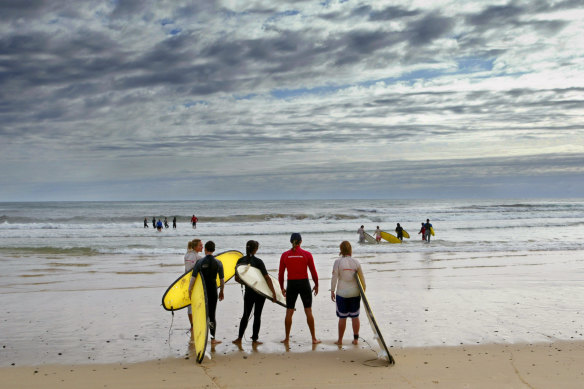This was published 4 years ago
Just swell: catching the perfect break, decades on, at Crescent Head
By Tim Elliott
In the Easter of 1985, when I was 15, two friends and I caught a train from Central Station in Sydney to Kempsey, on the NSW North Coast. Each of us had a surfboard, a sleeping bag, a towel and a tracksuit. From Kempsey we got a taxi, squeezing in with all our gear for the 20-kilometre drive to Crescent Head, where we pitched our tent in the campground. It rained the whole time we were there. We were cold and wet; our tent leaked and our sleeping bags got soggy and fungal – yet it remains among the most fantastic five days of my life.

"You see wave after wave, peeling away, lacquered by the low sun. And suspended over the hills beyond, downy drifts of mist."Credit: Dallas Kilponen
That trip began a lifelong love affair with the place. I go there every year with my family, sometimes twice a year. Nestled in the north-facing bowl of a low hill, Crescent is the quintessential low-fi, no-fuss Australian surf town, a key stop on the Pacific coast, about six hours’ drive north of Sydney. It’s a fabled wave, with ruler-straight lines of swell that sweep down the long, rock-lined point, breaking seemingly forever, on and on, past the pandanus on the shoreline, past the car park where people sit watching in their Kombis, past the surf club and the pine trees and on towards the beach.
On the right day, under the right conditions, it’s a majestic sight. If you walk up to the headland at sunset and look back down the point, you see wave after wave, peeling away, lacquered by the low sun. And suspended over the hills beyond, downy drifts of mist and sea spray. Crescent, which has a population of about 1500, has become increasingly popular, especially with families. But there remains a certain scruffiness to the place. Not much appears to have changed.
There’s the country club, Barnett’s Bakery, the tavern, and a six-hole golf course overlooking the ocean where players scoot about in carts with one hand on the wheel and another holding a beer.
The back road is still mostly unpaved, so grievously potholed and corrugated it’ll rattle the teeth right out of your head. So far, the developers have been kept at bay. Driving south past Racecourse Beach towards Point Plomer and Queens Head, you pass lushly grassed paddocks, cows, craggy headlands, trackless beaches backed by dense bush. In spring, great caravans of humpback whales head south, their spume like smoke signals far out to sea.
The town itself overlooks Killick Creek, a tidal inlet, perfect for lying in the shallows or floating about on a paddle board. Kids can throw a line in and fish for tiddlers. Behind that, just inland, is the Belmore River. There’s a narrow road that hugs the banks as you head north. Every hundred metres or so you’ll drive past an old timber house, painted white and built on stilts, in case of flood. It’s like something out of America’s Deep South. Hot, slow and slightly neglected. Verandahs with cane furniture and swing chairs. Rope swings in the front yards. Buttery sunlight. There are avocado trees and weeping jacarandas; in places, the canopies of giant fig trees droop right over the road. After about half an hour, you’ll come to the pretty little town of Gladstone, where you can get a beer and plate of prawns at the Heritage Hotel.
Teenage kids love Crescent. There are plenty of places to escape their parents, lots of rock jumps and secret beaches. And the bakery, naturally.
One time, some years ago, my wife and I and our three daughters were walking along one of the back beaches. It was the Christmas holidays, yet we were the only people there. Soon we noticed that the sand was littered with dead cicadas, all Black Princes. Die-offs like this are apparently natural. It’s just what happens.
We collected a cicada for each of us. The sun and the salt had perfectly preserved them. We took them home and put them on our bookshelf. They have black, shiny eyes and wings like glass leaves. They’re fragile but very beautiful, and they always remind me of Crescent.
To read more from Good Weekend magazine, visit our page at The Sydney Morning Herald, The Age and Brisbane Times.